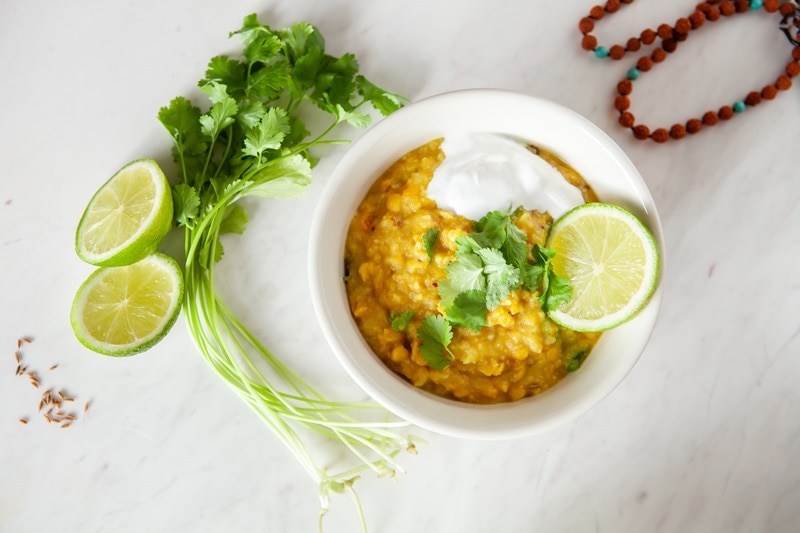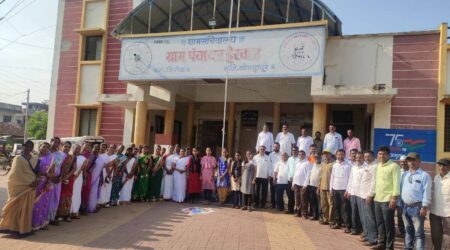by Dr. Bhaswati Bhattacharya
Of the many terms used for food, the Sanskṛt term āhāra reminds us that food is more than what we swallow. Meaning to bring near, to bring into oneself, āhāra takes a deeply spiritual view that all five senses feed us. What we take into our bodies, consciously or unconsciously, becomes part of our tissues.
Ayurveda asks us to deepen our awareness of when, how, what, where, why, how much, and with whom to eat. When we align these, the food in our mouth is swallowed as nourishment. When we are not aligned, the food can lead to indigestion.
To know what to eat, we must become aware of the qualities, or gunas in Sanskrt, coursing through our body. The main gunas relevant to diet are heavy-light, dry-moist, sharp-dull, and cooling-heating.
Different layers of recommendation address different levels of appetite, different weights, people with poor or irregular bowel movements, cravings, emotional eating, irregular or poor digestive fire, fatigue, and different constitutions.
The power of individualizing a diet allows Ayurveda to rightfully use food as medicine.
If your body is dry, eat moist foods. How will you know if your body is dry? You will have dry rough skin. You will have dry hair and a dry scalp. You will have dry deposits in the corners of your eyes when you wake up, and your skin may be flaky, especially around your elbows, knees, hands and feet. But more than the outside, your body will give signs of dryness from inside. You will be constipated. You will be thirsty. You will have random shooting pain that runs through your body. You may have a dry cough. Sometimes your movements will not be smooth. Ayurveda sees all these symptoms as dryness. To counter them, moisture must be replenished to the microlevels of the body.
Moist foods should be tried to see whether they alleviate these symptoms. To start, focus moist foods into every meal for 1 week. Revert to your usual diet for 1 week again, then evaluate.
You may take recipes from the moist foods that are usually eaten in the early months of autumn and winter when the body coincidentally becomes dry and rough from the windy, cooling weather. During this time, we eat warm soups with rich ghee or oil, root vegetables with their natural oils, nuts and seeds, and rich meats. Moister foods are naturally available from the harvest at this time too.
At night, sesame oil should be warmed and rubbed under your feet. Two drops of cultured ghee should be rubbed into the navel twice a day. Coconut oil should be massaged into the scalp 1-2 times a week at least an hour before showering.
If you are hungry, eat nourishing foods that satiate that inner hunger. How will you know if your cells are hungry, and this is not a craving? Do you go to bed and then find yourself hungry in the night? Do you wake up very hungry? Try eating khichdi every day for 5 days. If you are truly hungry, the khichdi will satisfy your hunger. Your bowel movements will feel more full and your body will feel light afterward. Find recipes that feature moist, heavy, easily digestible food such as rice, fresh dishes made from fresh ingredients not leftovers. Use cultured ghee, olive oil, and avoid refined oils.
Heavier foods are usually recommended in the months of winter when the body’s central heat is not dissipated by sweat and copious movement during cold weather. During these months, the digestive fires, known as jatharagni and dhatu-agni are high. Begin with a glass of freshly-boiled water to settle the belly if you are overweight.
Ayurveda recommends starting the day with rice-based preparations. Natural and local rice around the world is the most bio-assimilable food. Known as anna, it is that food which is eaten and absorbed into the body’s tissues most completely. This pulling into the body is one reason that rice is part of the BRATT diet (banana, rice, applesauce, toast, tea) that curbs diarrhea, by promoting the body to absorb nutrients.
Heavier vegetables local to the environment such as potatoes and sweet root vegetables such as carrots, beets and yams provide fullness. Foods made of godhuma (whole wheat with the bran and germ attached) provide satiation of hunger. Sweets made of milk and grains can be eaten. These foods send us toward better solutions to solve the chronic problem of hunger in people who are eating the typical western, urban, modern diet, unaware of the role of calories, which measure energy in a crucible in the laboratory in comparison to the Ayurvedic parameter of digestibility, which measures the body’s response to taking nourishment deep into the cells.

Dr. Bhaswati Bhattacharya
The South Asia Times Columnist Dr. Bhaswati Bhattacharya is a Fulbright Specialist 2018‐2022 in Public Health and Clinical Asst Professor of Medicine, Weill Cornell Medical College, New York. Her bestselling book Everyday Ayurveda is published by Penguin Random House. [email protected] | www.drbhaswati.com











